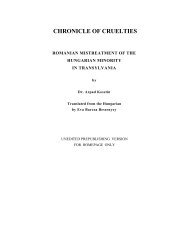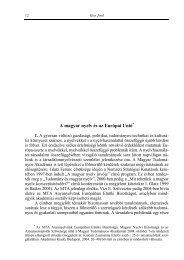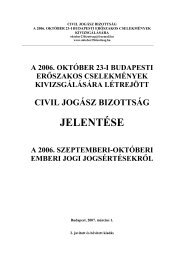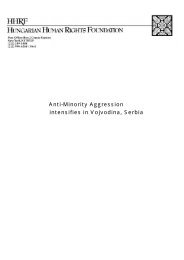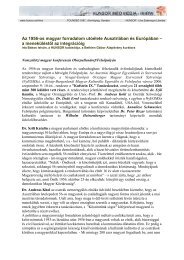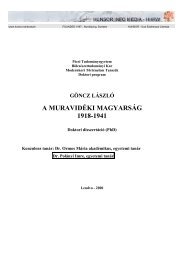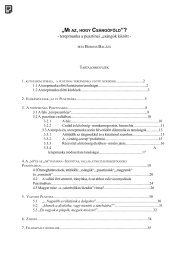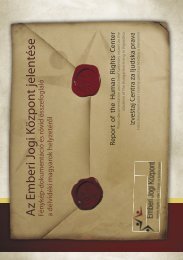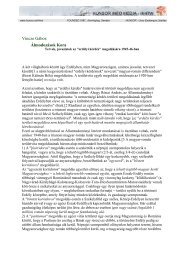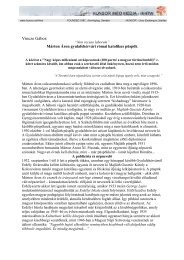"My younger brother, Bandi, was taken away on Sunday and was executed in the yard of theVillage Hall. The Feketes were executed at the same time, father and sons, in the order of theirages; Janos, Sandor, Feri and all the younger ones too. All the male members of the Bun andGosztonyi family, and old Teca111Hagymas. She had been outspoken all her life, and kept talking back to them insolently:"Shoot in my ass", she turned her backside towards them; she was shot in the head.Terus Kelemen and an other woman was also executed then.Mihaly, my husband, managed to hide on the farm. One night he came for me: "Let us flee toNovi Sad". We hid there till spring; this was not without danger. My parents were taken to theJarek camp in January."Those few who were left alive were driven to Backi Jarek on January 23, 1945. Their homes andall other properties were confiscated; they could only take their clothes with them. Those whohad a horse or a cart were allowed to go to Jarek by cart, but once there, their horses and cartswere taken from them. There was much starving and torment in the transit camp too. Many diedof hunger, others of epidemics. An old German internee was given the job of picking up the deadevery morning with a wheelbarrow. He collected and buried about twenty or thirty dead bodieseach day.The guards were very cruel. In the middle of winter, the internees were forced to walk fromJarek to Gojdobra in the severest cold. One of the women was from Martonos originally, andwas moved to Zsablya well after the raid in 1943. Her husband was immediately executed, whileshe was interned along with her ten month old daughter. They were poorly dressed, she had towalk from Jarek to Gajdobra in the coldest weather. At one point, the baby's scarf fell off herhead. The cruel and bloodthirsty partisan who was escorting them did not let the mother pick upthe child's scarf, saying, "She does not need it, at least she'll croak sooner".According to reliable estimates, at least 2000 of the Hungarian population of Zsablya died, mostof them were executed in their village, but many died of starvation or contagious diseases incamps.DEATH OF THE PUNTERSTo the Punter Districts belong, besides the already mentioned Csurog and Zsablya,Sajkasgyorgye (Gyurgyevo). Sajkaslak (Lok), Dunagardony (Gardinovce), Sajkasszentivan(Sajkos), Tiszakalmanfalva (Budisava), Tunderes (Vilovo), Mozsor112(Mosorin), and the "capital" or "capital village", Titel. These villages have been privileged sincethe Turks reached the Danube. The Punter Organization was born around the time when theTurks came to our frontiers. After they had been driven away. the Punter Soldiers relocated theirquarters for the defence of the frontier Pozsony and Komarom to the Punter District of Titel,functioning up to the end of the 18th century. After the expulsion of the Turks, there was a
Serbian majority among the punters. Some of their privileges, which were the pride of the swiftboatmen, remained intact.Puntership is much older than infantry; it preserved far more features of ancientHungarian warfare. The Danube did not allow the use of large warships. Instead, the small boat(sajka-punt) ) was used for defence, transport and even offensive operations during the Turkishwars. The institution, whatever the crew working within it, kept its Hungarian character.Navigation had demanded special knowledge. It wanted only professional soldiers andprofessional boatmen. Chiefs had been elected from among the crew. The private soldier, if hedistinguished himself, became a corporal and a nobleman. The best corporals then becamechieftains.The treasury paid the Punters by the year. They had a number of privileges. With theadvent of modern warfare the importance of the Punter Force disappeared, but the spirit of thesefearless fighters of the rivers lived on. <strong>This</strong> inherited self-confidence has remained prevalent inthe neighborhood of Titel up to our time. The Hungarian military authorities, as well as Tito,should have taken this to account in the vendetta, when they roused and unleashed the punters'anger.Gyurgyevo and the RusynsThe subsequent investigation by Hungarian military authorities failed to recognize theconsequences of the raid affecting Sajkasgyongye. Whether there were partisans here in 1942, itwould be hard to say today. What is certain knowing the nature of the organising methods ofthe partisans, they could have had supporters. Did they deserve sanctions for that? Maybe. The1946 report from Novi Sad records two hundred and forty-four Serbian and Rusyn victims.Almost half of the four thousand and five hundred people living there were Rusyns.The majority of the 300 Hungarians, when sensing the desire for revenge , leftGyurgyevo on the heels of the retreating Hungarian forces.113For lack of Hungarians to take revenge on, the Serbians vented their anger on the Rusynpopulation. <strong>This</strong> was due to the fact that, having had no contact with the partisans during theraid, they had hardly suffered any losses.They had been fair to the Hungarian authorities from the beginning, a fairness which thelater returned. The partisans, besides massacring the few Hungarians who did not leave, theybehaved as cruelly to the Rusyns as if the later were Hungarians. They executed the headmaster,Marvojlovics, because he spoke Hungarian and supported the idea that besides knowing theconversational language, children in his classes should learn Hungarian. They cruelly torturedthe Greek Catholic priest Michael Boszormenyi. He was shoed like a horse and driven to NoviSad barefoot in that pathetic condition, only to be executed after further cruel tortures.In 1944 several hundred Rusyns fell victim to the partisans in this way as a consequenceof the 1942 raid which they had nothing to do with. The reprisal did nor spare those who showedthe slightest sympathy with the Hungarians or those who expected the Serbian RoyalGovernment, with its seat in far-off London, to return.Also doomed to die was an aged woman, Kata Babe, who operated a small boardinghouse. In 1943, she received an order from a Serbian youth to poison, on "superior orders", the
- Page 3 and 4:
Library of Congress Catalogue Card
- Page 5 and 6:
Mutilation of the hands or feet wit
- Page 7 and 8:
they wanted to belong. On the annex
- Page 9 and 10:
individuals, then shooting them by
- Page 11 and 12:
the Russians and under their protec
- Page 13 and 14:
22PEOPLE OF BEZDAN1.On a May aftern
- Page 16 and 17:
26that those people all fell victim
- Page 18 and 19:
ack a 13 year-old boy to the soccer
- Page 20 and 21:
Russian officers cursed and told th
- Page 22 and 23:
Jani was set free for he had been a
- Page 24 and 25:
There were some people who, in spit
- Page 26 and 27:
March 12, 1945. The relatives of th
- Page 28 and 29:
Ferenc Csapo, 33 Mihaly Miovacs, 18
- Page 30 and 31:
Having heard about the advance of t
- Page 32 and 33: "On November 3, I got up at five in
- Page 34 and 35: The vicar would come every night. H
- Page 36 and 37: hand. Raising it to his mouth, he d
- Page 38 and 39: "24th October, 1944. Yesterday was
- Page 40 and 41: "I have only one chance to be sacri
- Page 42 and 43: The data, which shows that on the s
- Page 44 and 45: all the captured Serbs, as neither
- Page 46 and 47: Before and during World War II, the
- Page 48 and 49: would order fire in an instant. Wit
- Page 50 and 51: Our house looked out over the main
- Page 52 and 53: He had just arrived home after thre
- Page 54 and 55: 28. Jozsef Pasztor, 34 56. Albert G
- Page 56 and 57: The OZNA officer, who exhumed a mas
- Page 58 and 59: 7917 year old Karoly and 8 year old
- Page 60 and 61: 82FROM SZENTFULOP TO THE GAKOVA CAM
- Page 62 and 63: My mother died on January 4, 1946.
- Page 64 and 65: Jozsi, the leader of our committee
- Page 66 and 67: his own grave, then machine gunned
- Page 68 and 69: driving a wheelbarrow on the sidewa
- Page 70 and 71: "Now that's exactly what we needed
- Page 72 and 73: 15 Istvan Polyakovics, Zenta, 18861
- Page 74 and 75: idge was built (from several rows o
- Page 76 and 77: There is a common opinion among the
- Page 78 and 79: The Catholics of the village were o
- Page 80 and 81: and their supporters. On one occasi
- Page 84 and 85: two young instructors staying in he
- Page 86 and 87: In Tunderes (Vilova) there was no o
- Page 88 and 89: weeks spent starving, laying on str
- Page 90 and 91: 121PACSERAt Pacser sixteen Serbians
- Page 92 and 93: piece of land, there are three rows
- Page 94 and 95: "I understood that through the OZNA
- Page 96 and 97: took the priest under their protect
- Page 98 and 99: "We set off from Hadikliget on Octo
- Page 100 and 101: everyone to the front! The Party us
- Page 102 and 103: 137REPORT OF LOSSESIn addition to o
- Page 104 and 105: 141Source: Zlocini okupatora u Vojv
- Page 106 and 107: well as in words, that there had be
- Page 108 and 109: The American military forces delive
- Page 110 and 111: culpability or participation are th
- Page 112 and 113: The accused did not make use of his
- Page 114 and 115: the spirit of revenge among the Hun
- Page 116 and 117: considered all the claims of Hungar
- Page 118 and 119: The People's Court of Budapest just
- Page 120 and 121: From then on all hell breaks loose.
- Page 122 and 123: Recommended readingeRudolf Kiszlion



